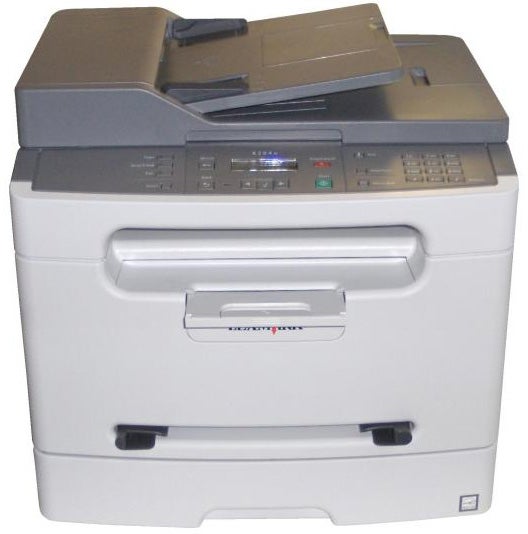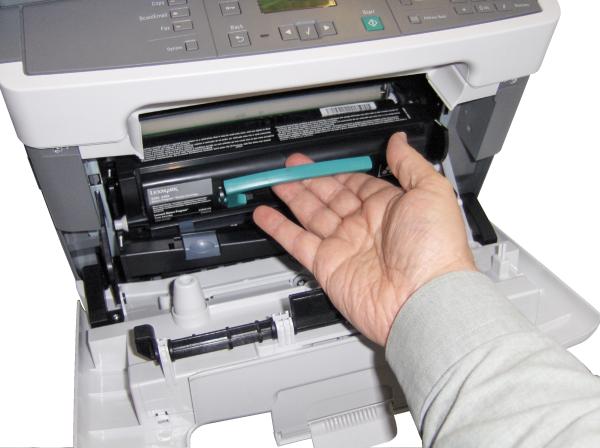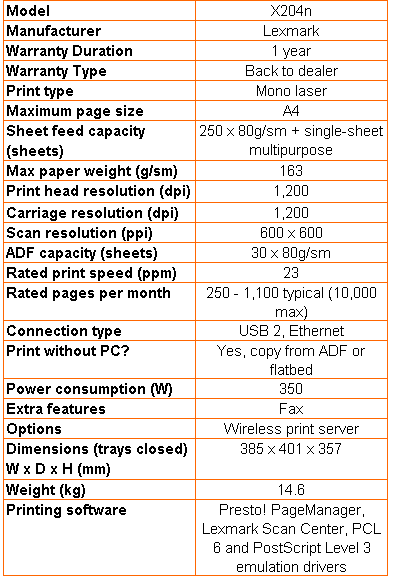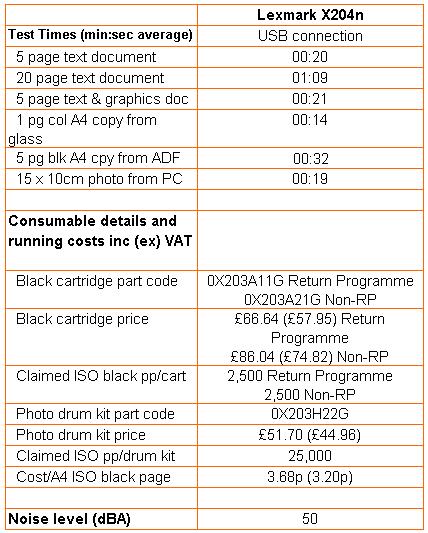Lexmark X204n – Mono Laser MFP Review
Lexmark X204n – Mono Laser MFP
This mono laser incorporates a scanner and faxing ability.

Verdict
Key Specifications
- Review Price: £205.23
Any mono laser printer with a scanner on top can be called a multifunction printer. The extra functionality comes from the ability to copy and in many cases to send and receive faxes. This combination is ideal for most small and home offices and Lexmark’s X204n has a neat footprint and a fair turn of speed, to boost its appeal.
It’s rather square-cut looks are functional, with a 30-sheet, dark grey Automatic Document Feeder (ADF) contrasting with the cream front and rear panels. The scanner itself is a Contact Image Sensor (CIS) device, which has the advantage of a very shallow mechanism, but some problems scanning greyscale prints.
The control panel is well laid out, with a 2-line by 16-character, backlit LCD display set in the centre. Three navigation buttons directly in front of the display, along with Back and Menu buttons, control all setup parameters, with a column of small function keys to switch between copy, scan and fax modes on the left and a keypad and other fax-related buttons on the right.
Directly below the control panel is the output slot for printed pages and, although this has a small extension with a flip-up paper stop, if you’re using A4 paper, you probably won’t need to extend it. At the base of the front panel is a 250-sheet paper tray and there’s a single-sheet, multi-purpose slot directly above this, for special media.
At the back are sockets for USB and Ethernet, as well as for a phone line and handset. As with any multifunction machine including fax, connecting your phone through the printer enables fax calls to be taken automatically, without deafening you with fax tones.
Software provided with the machine includes Presto! PageManager, Lexmark’s Scan Center and emulated drivers for both PCL and PostScript. All the software installed without problem. Drivers are also available for Windows, OS X, Linux in a variety of distributions, Citrix MetaFrame, Novell and UNIX. This is an impressive list for a comparatively low-end device.
Speed tests with the original installation, which turned out to be the PostScript emulation driver, showed up a rather odd print error. On any multipage documents there was a pause of 8 to 10 seconds between each page, rendering any kind of speed measurement pretty redundant.
A call to Lexmark technical support got them checking with their own machine and duplicating the problem. They sent us the latest PCL driver, which corrected the pausing, but there obviously needs to be a little work on the PostScript code.
When we got our printer running correctly, it produced some impressive speeds. Although we didn’t see the rated 23ppm, our five-page document completed in just 20 seconds, giving 15ppm and this increased to 17.39ppm for the 20-page job. The five-page text and graphics document took 21 seconds, so only slightly slower, and our 15 x 10cm photo print, in the best 1200dpi print mode, took 19 seconds.
If you compare this with something like the Samsung SCX-4824FN, reviewed recently, all the Lexmark speeds were slightly faster, ranging from 1ppm to 5ppm. The instant-on fuser in the Lexmark machine makes printing seem quicker still, as it starts almost immediately.
The quality of prints from this printer depends very much on what you’re printing. Text, at the 1200dpi-like normal resolution, is very sharp and black. This makes it particularly easy to read. Greyscale graphics are fair in the lighter shades, but tend to be too dark when they are below mid-tone.
Our photo picture reproduced moderately well, though there was some banding in the sky and virtually all shadow detail was lost to black. There are also problems when scanning greyscales on the machine to produce copies. They come through very dark, with striated images which are next to useless. If you try and copy anything with printed photographic content, you’re likely to get poor results.
What appears to be a single consumable is in fact a two-part drum and toner unit. The toner is rated at 2,500 pages, while the drum itself should run for 10 toner cartridges, as it lasts 25,000 pages. The toner cartridge is available as a Return Programme part, at reduced price and including postage back to Lexmark’s recycling centre. The company is rightly proud of the fact that up to 90% of its cartridges sold in the UK pass through its recycling programme.
The ISO cost per page works out at 3.68p and, comparing this with results from the Samsung SCX-4824FN, the Lexmark costs roughly 1.40p more per page to run.
Verdict
This is a good, general-purpose multifunction printer, with a fair turn of speed, but with some shortcomings in its copy quality and a driver glitch which needs sorting. It also costs noticeably more than some of its rivals to run, unless we see a drop in the consumable price as it becomes more widely available.


Trusted Score
Score in detail
-
Print Speed 8
-
Features 7
-
Value 6
-
Print Quality 7
Features
| Networking | Fast Ethernet |
Printing
| Paper Size | Envelope No. 10, Envelope No. 7 3/4, Envelope No. 9, A4, A5, B5 Envelope, C5 Envelope, DL Envelope, Executive, Folio, B5 (JIS), Legal, Letter, Statement, Universal, Officio |
| Sheet Capacity | 250 sheets |
| Rated Black Speed (Images per minute) | 24 ppmipm |
| Rated Colour Speed (Images per minute) | Not Applicableipm |
Scanning
| Scan Resolution (Dots per inch) | 600 dpi, 600 x 600dpi |

